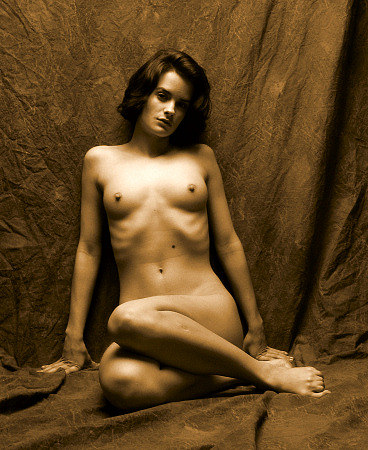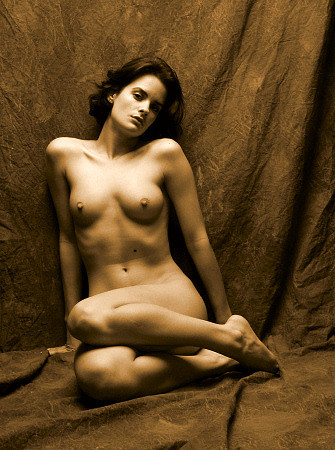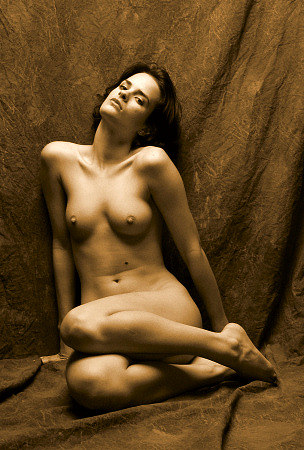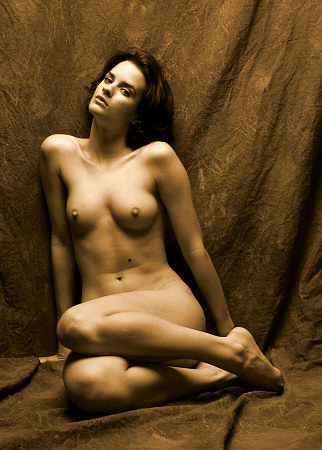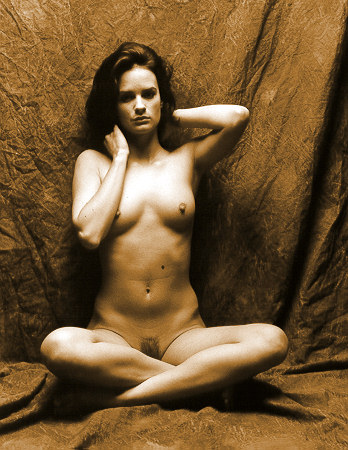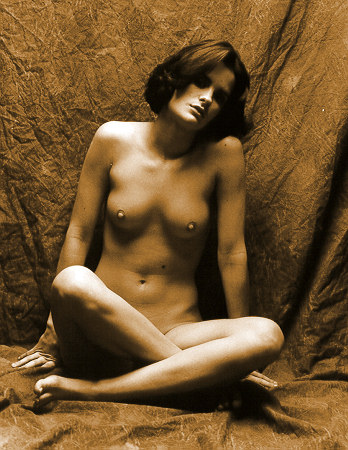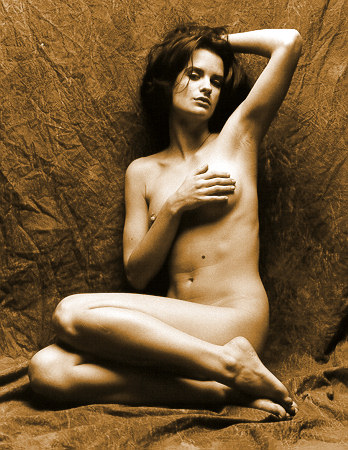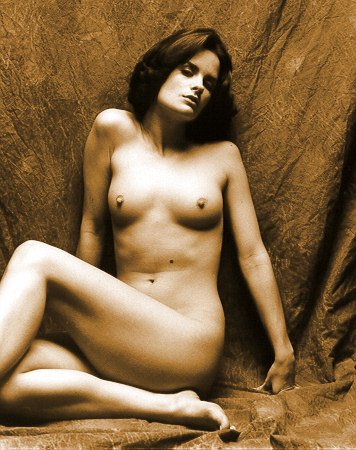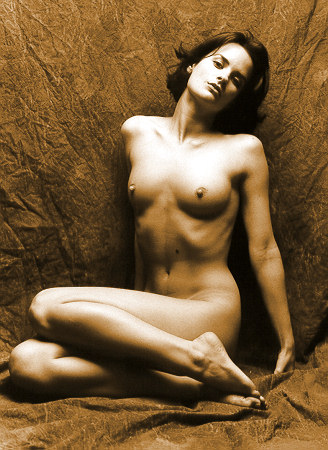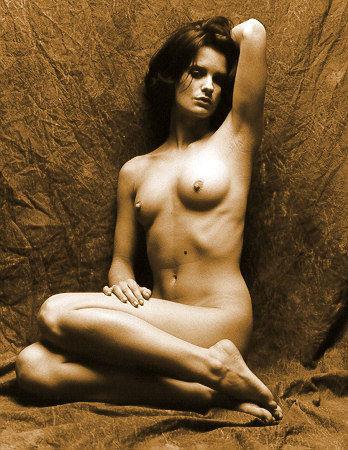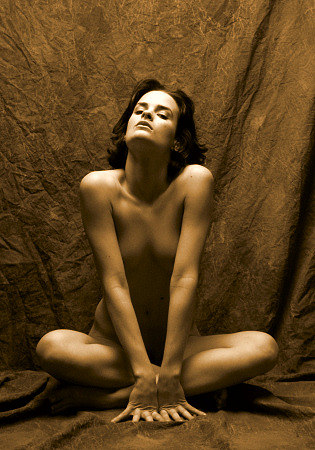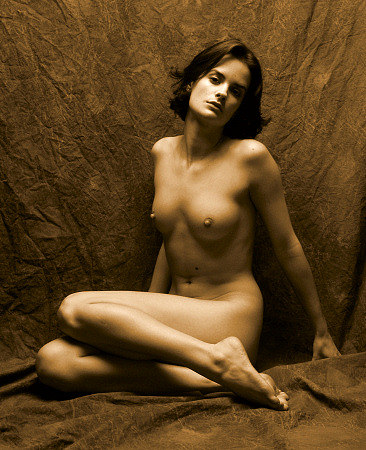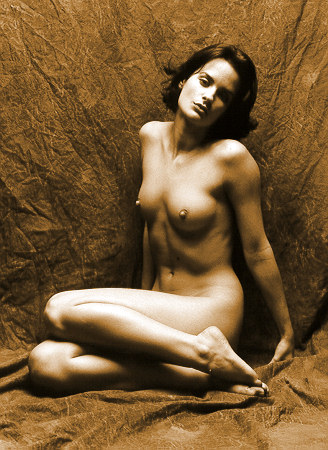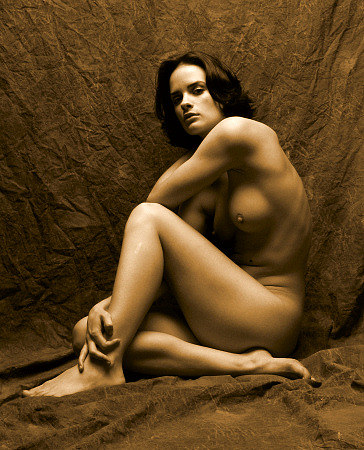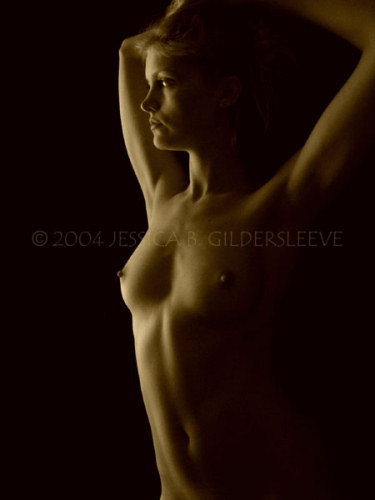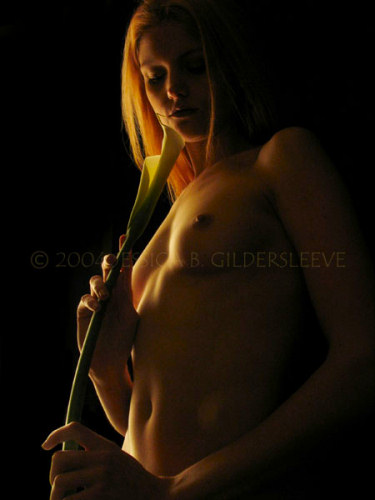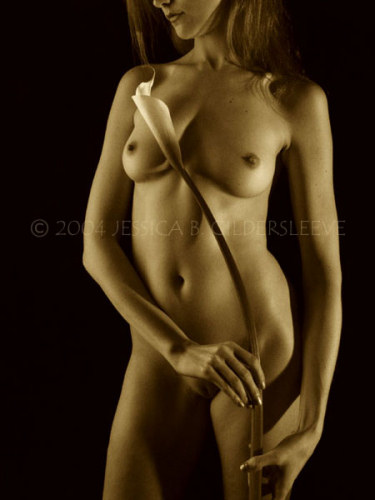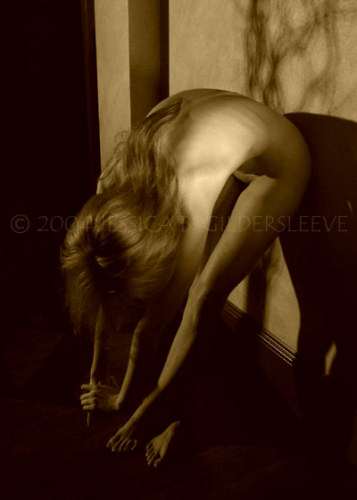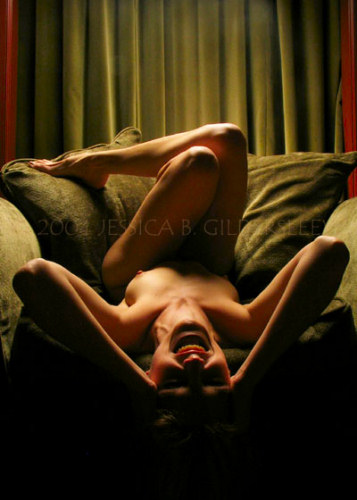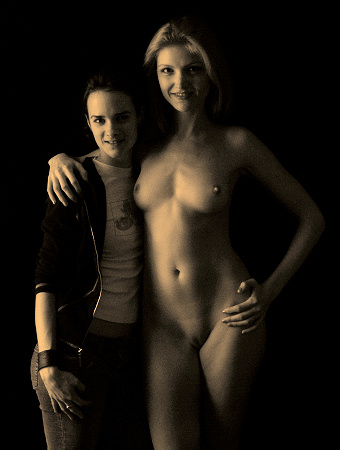When
I was living in California, I had a
room devoted to studio work. It
wasn't big enough, but it did have
advantages. Chief among these
was the fact that I didn't have to set
things up & put them away for each
sitting -- I just left the last
lighting setup up. But another
advantage is that I had a boom arm
installed at the top of a wall,
allowing me to put a light above the
model -- this was great for hair
lights. The boom was sturdy
enough to accept a light with a soft
box, creating soft down light,
somewhat like a skylight, which I've always felt was
lovely.
Now,
I do have an extra sturdy light stand
which accepts a boom arm, but I've got
to admit that I don't use the boom much. Even though the light
stand is sturdy, it's a little
precarious with the boom arm on -- it
has to be balanced with a counter
weight, and even so, I'm always afraid
that it'll tip over on top of the
model.
But,
since I'm showing Jessica a range of
possibilities for her sitting, I risk
it.
Jessica
liked this lighting enough to
use something similar for her
first setup when she
photographed Leona. A
couple of tips for using
this lighting:
- It's
good to put the light up
as high as possible; thus
tall ceilings are
beneficial.
- It's
also a good idea to put
the model low, on the
floor. That way,
there isn't a lot of
difference between the
intensity of the light on
her head versus the light
that strikes her feet.
- Light
placement is
critical. Change the
position of the light just
an inch or so, and there
is a radical difference in
the shadows.
- This
light is often poor for
lighting faces -- have the
model cheat her face
upwards a bit if this
bothers you.
|
|
|
|
One
challenge of this lighting is
to avoid heavy shadows.
Because of that, I often ask the model to tilt her head
back a bit.
Before
we go on, I should comment a
bit about Jessica's sitting
with Leona. I
recommended Leona for several
reasons:
- Leona
is gorgeous -- that much
is obvious.
- Leona
is reliable -- you can't
tell about a model's
reliability just by
looking at her, but Leona
is very dependable, a
trait that is much
appreciated by me &
other photographers.
- Leona
is so easy to get along
with. She is bright,
friendly, and
enthusiastic.
- Leona
is greatly supportive of
photographers, even
beginners.
|
| On
the day of Jessica's sitting
with Leona, Jessica arrived an
hour earlier than Leona.
We spent the time moving
things around & setting up
the first lighting
setup. She chose a setup
similar to this one, utilizing
my big comfy chair; she chose
to set it up in the dining
room instead of my living
room.
We
kept busy. It
took us a while to set things
up. Good thing, because
I think Jessica was a little
nervous & excited.
That's okay -- truth be told,
I get a little nervous &
excited right before a
sitting, too. That's one
of the reasons I like punctual
models. |
|
|
|
During
Jessica's sitting with Leona,
I tried very hard to stay out
of the way -- I restricted
myself to helping Jessica with
the technical aspects of the
sitting. For example, I
remember her looking at her
"light from above"
setup and asking for a bit
more shadows across Leona's
figure -- I reached up &
pushed the boom arm an inch further
back. Problem solved. |
| It
was somewhat tough staying out
of the way. I kept
thinking "I wouldn't do
it that way" or
"wow, that's a good idea
that I wish she'd expand"
or "isn't it time for her
to move on" or "what
is she looking at" or
"gosh, she found some
terrific lighting".
But
the truth is that I have great
respect for Jessica's innate
photographic abilities.
Here I have decades more
experience than she does, and
I feel that she's already a
peer of mine
aesthetically. There's
not much I can teach her about
seeing; she already has a
terrific eye. |
|
|
|
One
habit of mine has contributed
greatly to my development as a
photographer -- I look at a
lot of pictures, and I analyze
them to a good degree. I
especially try to figure out
how images were lit & how
the photographer set up the
image with his/her models.
I
believe that nude photographic
artists go through common
evolutionary steps or
plateaus:
- Level 0:
Beginners are happy just to photograph someone without clothes.
- Level 1:
Photographing an interesting person without clothes.
("Interesting" does not necessarily mean
"beautiful").
- Level 2:
Photographing an interesting nude person using interesting
lighting. (I'm here most often.)
- Level
3a: Photographing an interesting nude person in
interesting light doing interesting things. (I'm
here sometimes.)
- Level
3b: Photographing an interesting nude person in
interesting light in an interesting setting.
- Level 4:
Photographing an interesting nude person, in interesting light,
in an interesting setting, doing interesting things.
- Level 5:
All of the above, telling a story.
|
After
Jessica's sitting with Leona,
I wrote up a little critique
for her. The essence
was...
- She
has a terrific aesthetic
eye; she finds interesting
shapes in interesting
light.
- In
fact, she has everything
she needs to become an
exceptional photographer
except experience.
- Her
technical skills could be
improved, but that's
easy. If I had to
choose between having an
aesthetic sense or
technical skills, I'd
choose the
aesthetic. Anyone
can learn the technical
skills; only a special few
have the aesthetic vision.
|
|
|
I
haven't given you a digital
versus film, side-by-side
comparison in a while, so
here's one. |
|
Digital |
Film |
|
My
assessment: I'm getting
better at getting tonality out
of digital images, but film
still blows away digital's
quality. The film images
are still simply sharper
(better optics?), and I'm still
better able to get a full
range of tonality out of the
medium. |
|
|
So,
my advice to myself &
Jessica:
- Keep
the model engaged in the
sitting. You can't
just photograph a model
who is just sitting or
standing around.
- One's
technical skills need to
be sufficient to carry the
aesthetic message.
- You
should analyze pictures
all the time; figure out
how they were made &
what you'd do differently.
- There
is no substitute for
experience, so practice,
practice, practice.
|
|
Here's
a few images of Leona
made by Jessica a few
days later: |
|
|
|
|
|
|
|
|
These
five images (c) 2004 Jessica, used here with
permission of the
photographer.
|
|
|
Jessica
with Leona.
|
|
| As
I was writing this, I got a
call from Jessica, to thank me
for a birthday gift I had sent
her. (I sent her a
portfolio for her
prints). Great to hear
from her! She's looking
for a name/title for her
honors project; we discussed
it, but I don't think we came
up with anything yet. |
|
| One
final note: after Jessica's
first visit, I put together a Digital
Variations page to demonstrate some
digital enhancements and modifications
I had found here & there.
During this year, I've learned a lot
about controlling digital
enhancements, and I've
semi-permanently settled on adding
sepia toning to all my images.
Anyhow, here is that original
2003 "Digital Variations"
page, and here is a new
2004 "Digital Variations"
page. Enjoy.
Whew!
Jessica wears me out! We had
great, great fun. We made a set of
wonderful images during her sitting
with me; she made a bunch of wonderful
images during her sitting with Leona,
and we had great fun playing with my
photographic toys. We even had
fun going out to dinner (to a Jamaican
restaurant around the corner).
We talked about everything, and I feel
that we got to know each other much
better. She is such a
joy!
|
